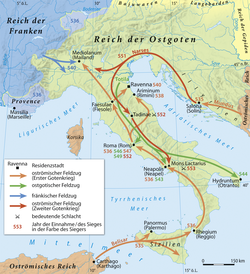Gothic War (535–552)
| Gothic War | |||||||||
|---|---|---|---|---|---|---|---|---|---|
| Part of Justinian's wars of Reconquest | |||||||||
 |
|||||||||
|
|||||||||
| Belligerents | |||||||||
|
Eastern Roman Empire, Huns, Heruli, Slavs, Lombards |
Ostrogoths, Franks, Alamanni, Burgundians |
||||||||
| Commanders and leaders | |||||||||
|
Belisarius, Mundus †, John, Narses, Bessas, Germanus, Liberius |
Theodahad, Vitiges, Ildibad, Totila †, Teia † |
||||||||
The Gothic War between the Eastern Roman (Byzantine) Empire during the reign of Emperor Justinian I and the Ostrogothic Kingdom of Italy took place from 535 until 554 in Italy, Dalmatia, Sardinia, Sicily and Corsica. Historians commonly divide the war into two phases:
The war had its roots in the ambition of the East Roman Emperor Justinian I to recover the provinces of the former Western Roman Empire, which the Romans had lost to invading barbarian tribes in the previous century (the Migration Period). The end of the conflict saw Italy devastated and considerably depopulated. As a consequence, the victorious Byzantines found themselves unable to resist the invasion of the Lombards in 568, which resulted in Constantinople permanently losing control over large parts of the Italian peninsula.
In 476, the Western Roman Empire in Italy was overthrown, when Odoacer deposed Emperor Romulus Augustulus and declared himself rex Italiae ("King of Italy"). Although he recognized the nominal suzerainty of the Eastern Emperor, Zeno, his independent policies and increasing strength made him a threat in the eyes of Constantinople. At that time, the Ostrogoths, under their leader, Theodoric, were settled as foederati of the Empire in the western Balkans, but were also growing restless. Zeno decided to "kill two birds with one stone", and sent the Ostrogoths to Italy to remove Odoacer, officially acting as the representatives of the Empire. Theodoric and the Goths were able to defeat Odoacer, and Italy came under Gothic rule. However, as per the arrangement between Theodoric, Zeno and the latter's successor Anastasius, the land and its people were regarded as still being part of the Empire, with Theodoric fulfilling merely the role of a viceroy and head of the army (magister militum). This arrangement was scrupulously observed by Theodoric: the administration continued in its old form and was staffed exclusively by Romans, and legislation remained the preserve of the Emperor. At the same time, the army remained the exclusive preserve of the Goths, who came under the authority of their own chiefs and courts. The two peoples were further kept apart by faith: the Roman population was Chalcedonian Christian, while the Goths were Arian Christians, although, unlike the Vandals or the early Visigoths, they practiced considerable religious tolerance. This complex dual system worked effectively under the capable and strong leadership of Theodoric, who knew how to carry out his own policy without alienating the Roman aristocracy, but began to break down during his later years and collapsed entirely under his heirs.
...
Wikipedia
